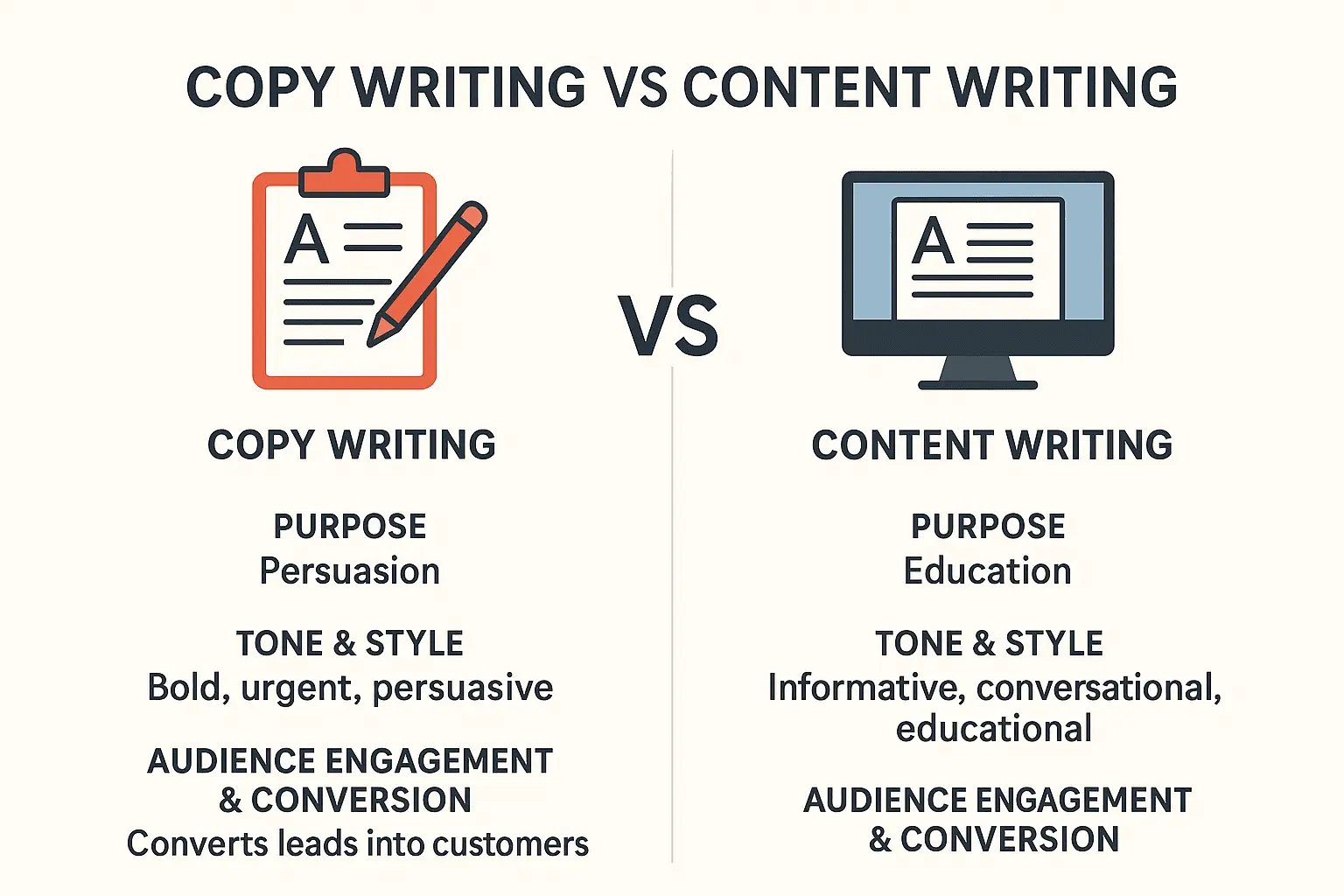Discover the key differences between copywriting and content writing—roles, skills, salaries, and career paths. Learn how both work together to drive results.
Introduction
Have you ever found yourself confused between copywriting and content writing? You’re not alone. These two terms are often used interchangeably, but in reality, they serve different purposes within marketing, branding, and communication. While copywriting focuses on persuading readers to take immediate action, content writing aims to educate, inform, and engage readers over time.
This article will walk you through the key differences, similarities, and future trends of copywriting and content writing. We’ll also look at real-world examples, career paths, and how businesses can leverage both to achieve success.
If you’re a business owner, marketer, or aspiring writer, knowing these distinctions can help you allocate resources wisely, sharpen your writing skills, and build a long-term strategy that drives results.
Copywriting vs Content Writing: The Key Differences
Here’s a side-by-side comparison table:
| Factor | Copywriting | Content Writing |
| Purpose | Drive action (sales, sign-ups, conversions) | Educate, inform, and engage |
| Tone & Style | Persuasive, urgent, emotional | Informative, storytelling, authoritative |
| Format | Ads, landing pages, emails, product pages | Blogs, guides, case studies, ebooks |
| SEO Role | Secondary | Primary (keyword-rich, evergreen content) |
| Length | Short-form (50–500 words) | Long-form (500–3000+ words) |
| KPIs | Conversion rate, CTR, revenue | Organic traffic, dwell time, backlinks |
What is Copywriting?
Copywriting is the art of persuasive writing that drives readers to take a specific action. This could be clicking a button, signing up for a newsletter, or buying a product.
Core Purpose
The main goal of copywriting is conversion. Unlike content writing, copywriting is not primarily about informing—it’s about selling, persuading, and converting.
Common Formats
- Sales pages
- Product descriptions
- Landing pages
- Ads (Google, Facebook, LinkedIn)
- Email campaigns
- Direct response letters
Skills Required
- Consumer psychology
- Crafting compelling CTAs (calls to action)
- Brevity and clarity
- A/B testing and optimization
- Understanding emotional triggers
Example
Copywriting Example (Facebook Ad):
“Stop wasting hours on spreadsheets. Try Our Tool today—save 10+ hours a week. Sign up free!”
This is short, action-oriented, and persuasive.
What is Content Writing?
Content writing is the practice of creating educational, engaging, and value-driven content designed to inform readers and build long-term trust.
Core Purpose
The main goal of content writing is to educate, entertain, and engage audiences, often as part of a long-term SEO or brand-building strategy.
Common Formats
- Blog posts
- Articles
- Case studies
- Whitepapers
- Newsletters
- Ebooks
- Website resources (FAQs, help pages)
Read this article on 3 most proven content writing examples that boost engagment and improve ranking
Skills Required
- Research & analysis
- SEO optimization
- Storytelling
- Clarity and readability
- Long-form writing structure
Example
Content Writing Example (Blog Intro):
“In today’s digital world, businesses face a common challenge: generating organic traffic. One of the most effective solutions is leveraging SEO tools. In this article, we’ll explore the top 10 SEO tools every marketer should use.”
This example educates, informs, and sets up an engaging piece of long-form content.
How Copywriting and Content Writing Work Together

The best marketing strategies combine both. Content attracts and nurtures audiences, while copy drives them through the conversion funnel.
- Top of Funnel (Content): Blog posts, guides, and infographics that attract organic traffic. Example – Blog on “Best Productivity Tools for Teams.”
- Middle of Funnel (Content + Copy): Case studies, whitepapers, and newsletters that build trust. Example – Newsletter recommending tool or service name.
- Bottom of Funnel (Copy): Sales pages, CTAs, and email campaigns that push conversions. Example – Landing page with persuasive CTAs to sign up.
Career Outlook: Copywriter vs Content Writer
Copywriter
- Copywriters focus on sales, advertising, and direct conversions. They are in high demand in industries like e-commerce, SaaS, advertising, and startups. In the U.S., average salaries range between $55,000 – $75,000/year (Glassdoor, 2024). Career growth can lead to roles such as Conversion Specialists or Creative Directors, with hybrid opportunities like Content + Conversion Writer also on the rise.
Content Writer
- Content writers focus on education, SEO, and long-term engagement. They are highly sought after in agencies, SaaS, publishers, and SEO-driven companies. In the U.S., average salaries range between $50,000 – $65,000/year (Indeed, 2024). With experience, content writers can transition into roles like Content Strategists or SEO Managers, while hybrid roles allow them to combine persuasive copy with educational content.
Future of Copywriting and Content Writing
A growing trend is the blurring of lines between both roles.
Blurred Roles
- Businesses increasingly expect writers to write content that sells and copy that educates.
AI’s Impact
- AI tools can generate drafts but need human expertise for voice, brand, and conversion strategy.
- Writers must adapt by becoming editors, strategists, and hybrid specialists.
Predicted Trends (Next 5 Years)
- Demand for hybrid “SEO Copywriters.”
- More emphasis on storytelling + persuasion in long-form content.
- AI-assisted content planning, human-led execution.
Real-World Examples: Copy vs Content
Example 1: SaaS
- Copywriting: Landing page headline — “Automate 90% of your reporting in minutes.”
- Content Writing: Blog post — “Top 10 Reporting Tools for 2025.”
Example 2: E-commerce
- Copywriting: Product description — “Get the perfect fit—50% off today only!”
- Content Writing: Buying guide — “How to Choose the Best Running Shoes for Beginners.”
Example 3: B2B
- Copywriting: LinkedIn ad copy — “Scale your business with our CRM in 30 days—Free Demo.”
- Content Writing: Case study — “How a Company Increased Conversions by 45% with Our CRM.”
Conclusion
Copywriting and content writing are not the same—but they are complementary. Copy focuses on persuasion and conversions, while content builds long-term trust and authority. The smartest businesses (and writers) know how to use both effectively.
If you’re deciding between the two for your career, consider your strengths. Do you enjoy persuasive, short-form writing? Copywriting may suit you. Prefer research-driven, long-form content? Content writing could be your path. Or, you can evolve into a hybrid writer with the best of both worlds.
👉 Next Reads:
- AI Content Writing: 5 Proven Steps to Create High-Quality Content
- How to Create an SEO Content Brief: Step by Step Guide
FAQs
1. Is copywriting harder than content writing?
Not necessarily. Copywriting requires persuasion in fewer words, while content writing demands depth and SEO research. Both need different skill sets.
2. Can one person be both a copywriter and content writer?
Yes. Many professionals today work in hybrid roles, writing persuasive copy and informative content.
3. Which has more career growth: copywriting or content writing?
Both fields are growing. Copywriting often leads to higher pay, while content writing offers more stable opportunities in SEO-driven industries.
4. How do businesses decide when to use copy vs content?
Use content to build awareness and trust; use copy to convert readers into customers.
5. Do AI tools replace copywriters or content writers?
AI can assist but not replace. Human creativity, empathy, and strategy remain irreplaceable.
